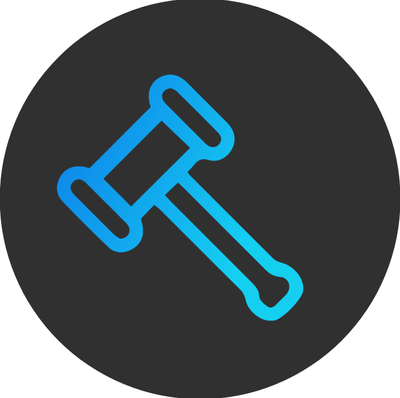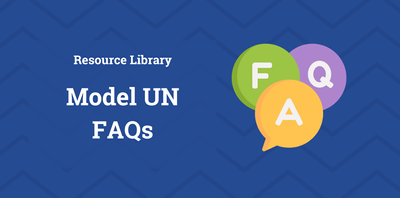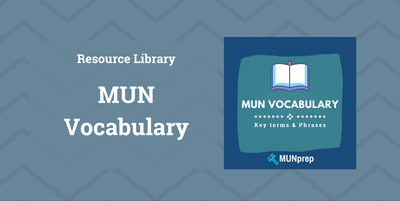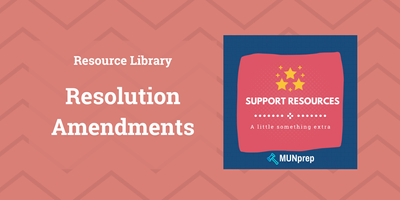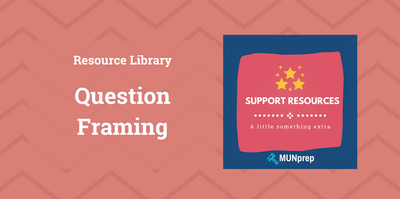Model UN Dress Code - Your Ultimate Style Guide
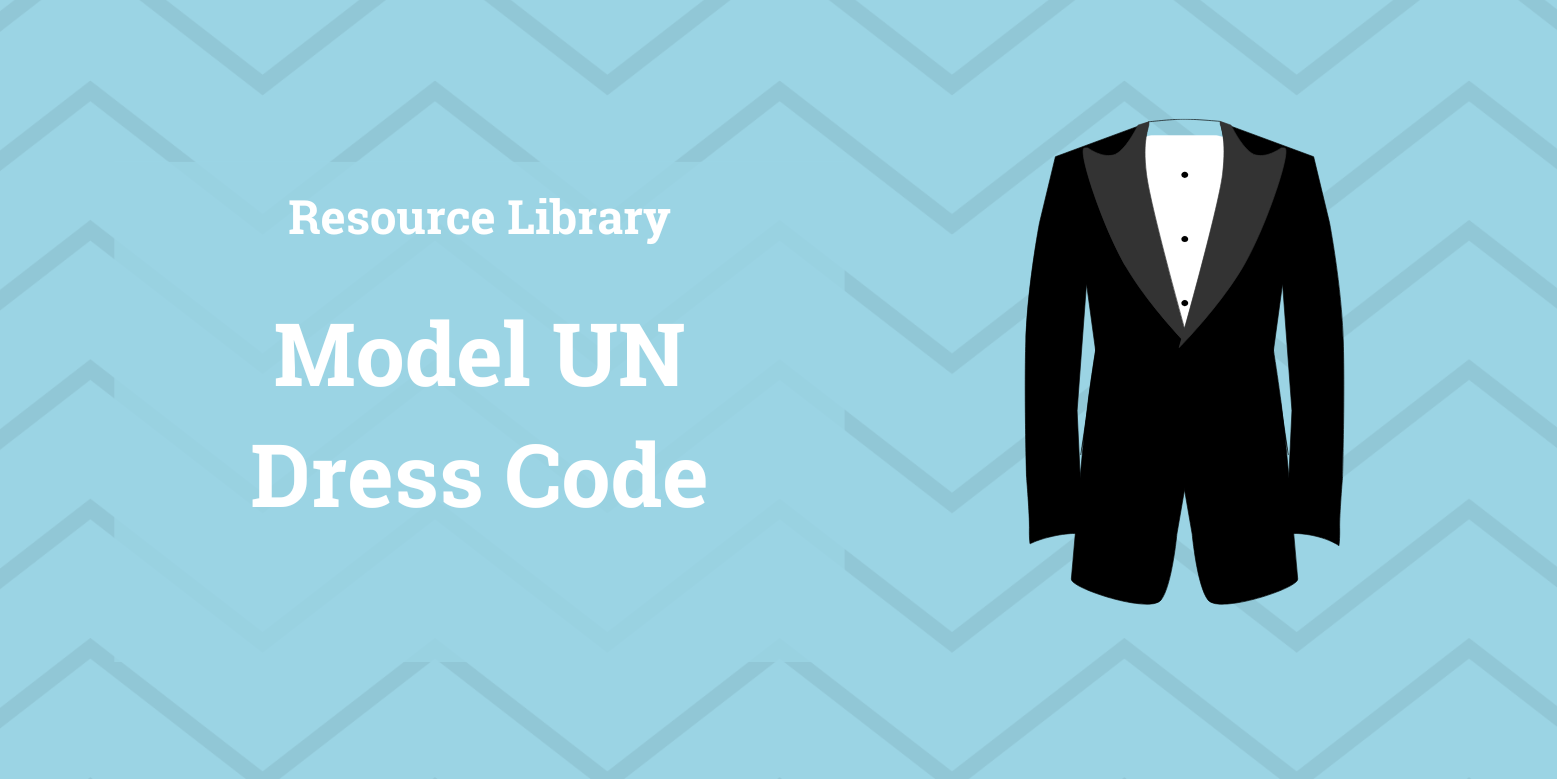
MUN Dress Code - The Essentials
In Model United Nations (MUN), dressing professionally is a key part of your role as a delegate. The way you present yourself helps convey confidence, respect, and credibility in committee sessions.
But what exactly can you wear to a MUN conference? What is appropriate and what isn't? The last thing you want is to turn up with a t-shirt and jeans and everyone else is wearing a 3-piece suit.
Fortunately, there are some pretty straightforward rules on what you can and cannot wear. So instead of just going through the rules, we'll also give you some suggestions on what you can wear to stand out and kick things off with an awesome first impression!
Why Dress Code Matters
There are three reasons why you should care how you look
- Establishes Credibility: Proper attire shows that you are serious about your role and well-prepared.
- Fosters Professionalism: It aligns with real-world diplomatic settings.
- Reflects Respect: Dressing appropriately demonstrates respect for fellow delegates, chairs, and the conference.
The Standard Dress Code - 'Western Business Attire'
Western Business Attire or 'Business Professional' will be the standard dress code for a MUN conference: It's basically a suit and tie for the men, for women it is some variation of a blazer with dress pants or a knee-length skirt, paired with a blouse or dress shirt.
It looks something like this:
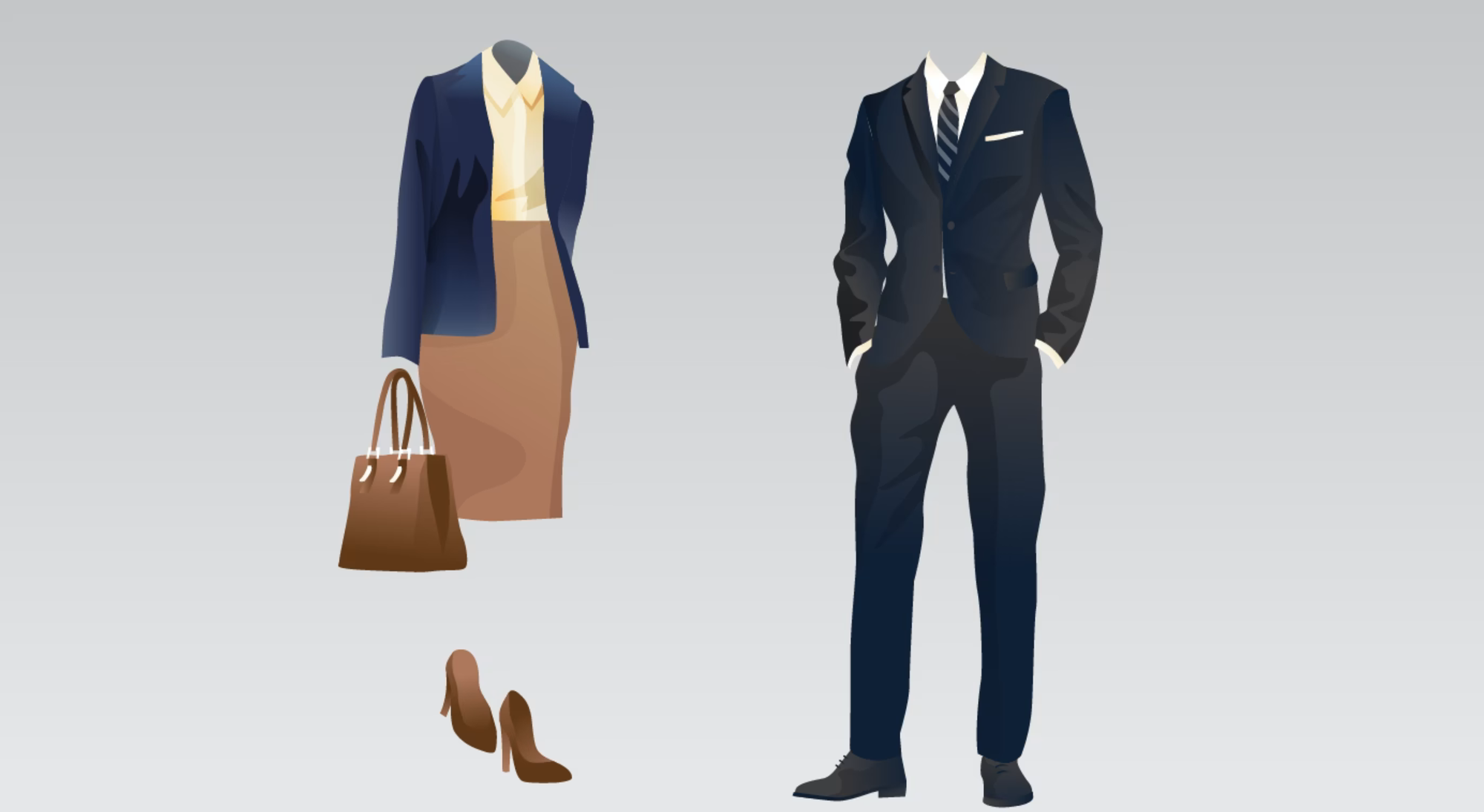
Our Model UN Style Guide
Up next, we've put together our own style guide on how to put your outfits together for your next MUN committee, walking you through outfits, bags, shoes and more!
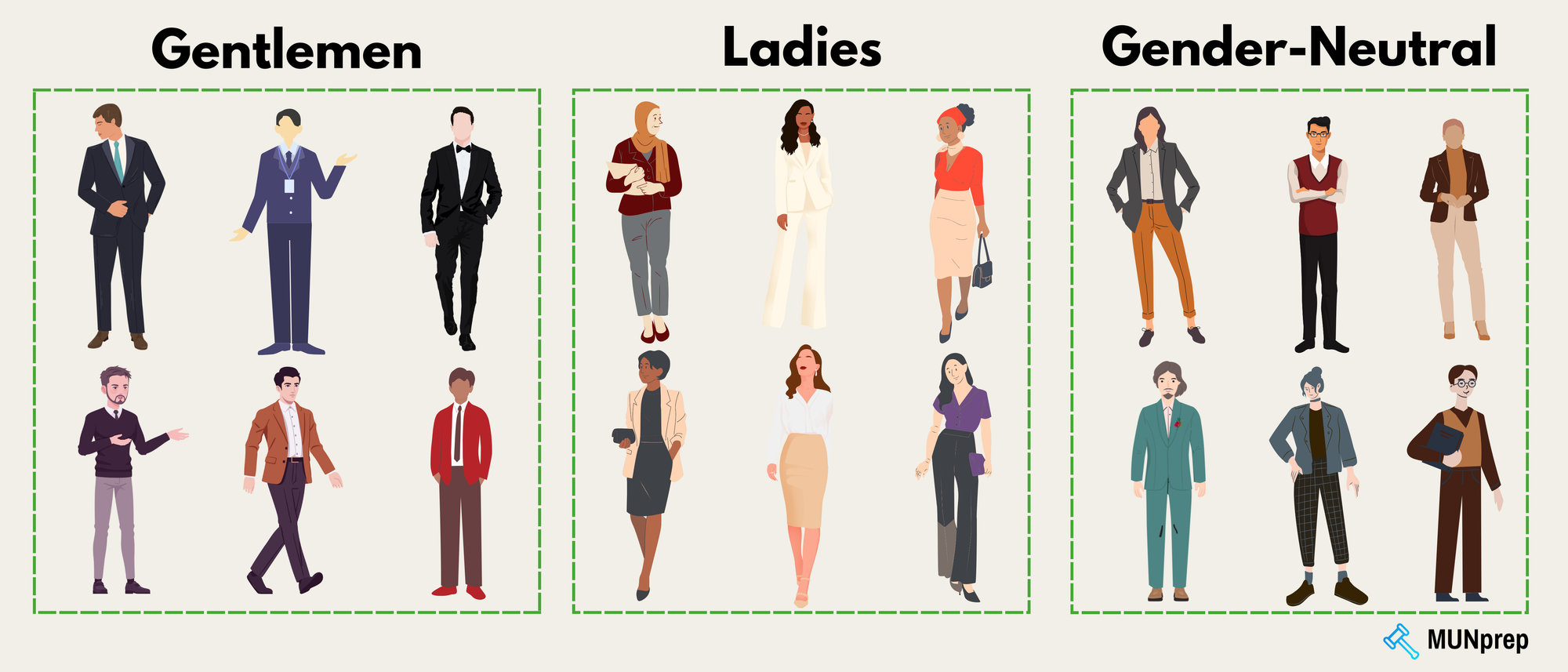
Skip ahead to any of the following sections to get more dress-code tips for your individual needs!
Men
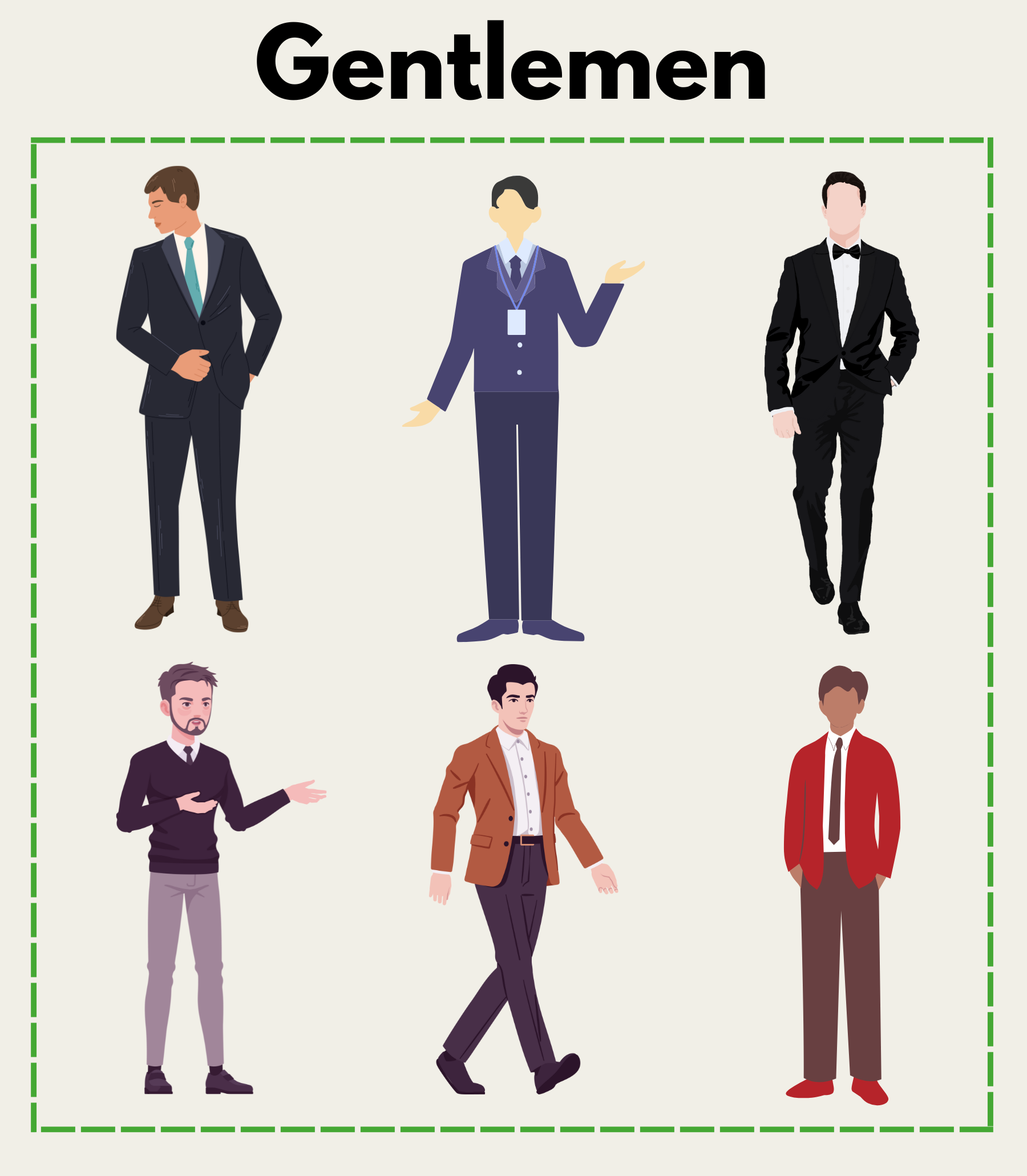
Dress-Code for Men
Men attending a Model UN conference are expected to maintain a professional appearance that aligns with formal business attire. This conveys respect for the diplomatic environment and fosters credibility in debate.
Standard Attire:
- Suits: A well-fitted two-piece suit in neutral colors such as black, navy, or gray.
- Shirts: A crisp, collared dress shirt in white or light pastel tones. Shirts should be ironed and free of visible wear.
- Ties: A conservative necktie in a solid color or subtle pattern. Bow ties are also acceptable but less common.
- Shoes: Polished dress shoes in black or dark brown, paired with matching dress socks.
- Accessories: A simple belt matching the shoe color and minimal jewelry. Watches should be professional and understated.
Acceptable Variations:
- A blazer paired with dress trousers, provided the combination is well-coordinated.
- Pocket squares or subtle lapel pins to add personality without being distracting.
- Loafers or monk-strap shoes in professional finishes, as an alternative to traditional oxfords.
Unacceptable Variations:
- Jeans, chinos, or casual pants.
- Polo shirts, T-shirts, or shirts with loud patterns or graphics.
- Sneakers, sandals, or any footwear that is not formal.
- Overly bold or flashy ties, hats, or accessories.
- Wrinkled or ill-fitted clothing.
Learn more about the Business Formal Dress Code for Men
Women
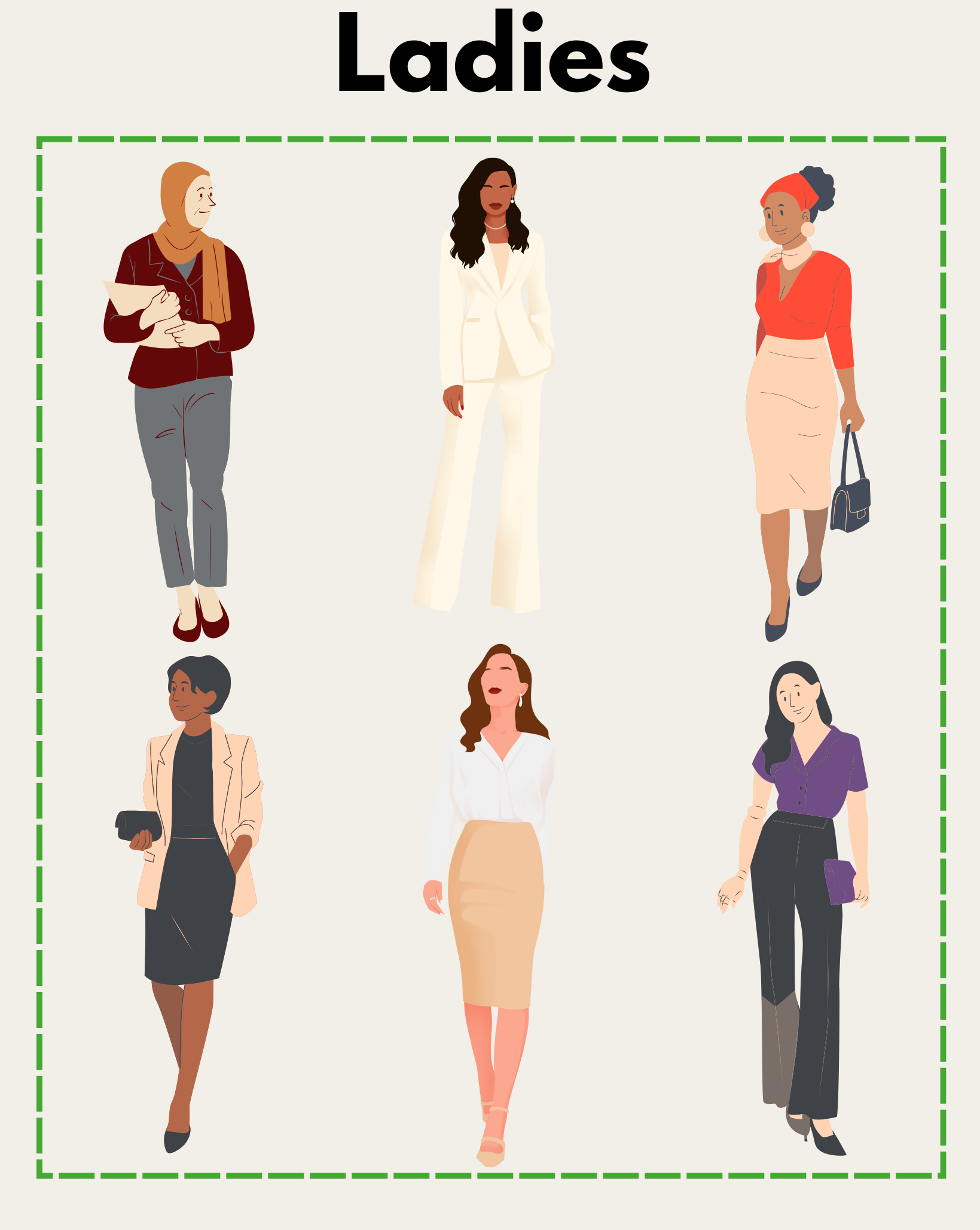
Dress Code for Women
Women at a Model UN conference are also encouraged to adhere to formal business attire, prioritizing professionalism while allowing room for individual style.
Standard Attire:
- Suits: A tailored pantsuit, skirt suit, or a sheath dress with a blazer in neutral tones like black, navy, gray, or beige.
- Blouses/Tops: Dress blouses or shirts in neutral or pastel shades, avoiding overly revealing necklines or designs.
- Shoes: Closed-toe heels or flats in neutral colors, ensuring comfort for long periods of wear.
- Accessories: Conservative jewelry, such as stud earrings or a simple necklace. A professional bag or portfolio is recommended.
Acceptable Variations:
- Dresses with sleeves or sleeveless dresses paired with a blazer, provided they meet knee-length standards.
- Block-heeled shoes or wedges as a comfortable alternative to stilettos.
- Subtle patterns on blouses, such as pinstripes or polka dots, as long as they are not overly bright or busy.
Unacceptable Variations:
- Mini skirts, shorts, or dresses with high slits.
- Tops that expose shoulders or midriff without appropriate layering.
- Flip-flops, sneakers, or platform shoes.
- Overly bright or distracting accessories, including large, jangling jewelry or glittery bags.
100 business formal dress code ideas
Gender Neutral
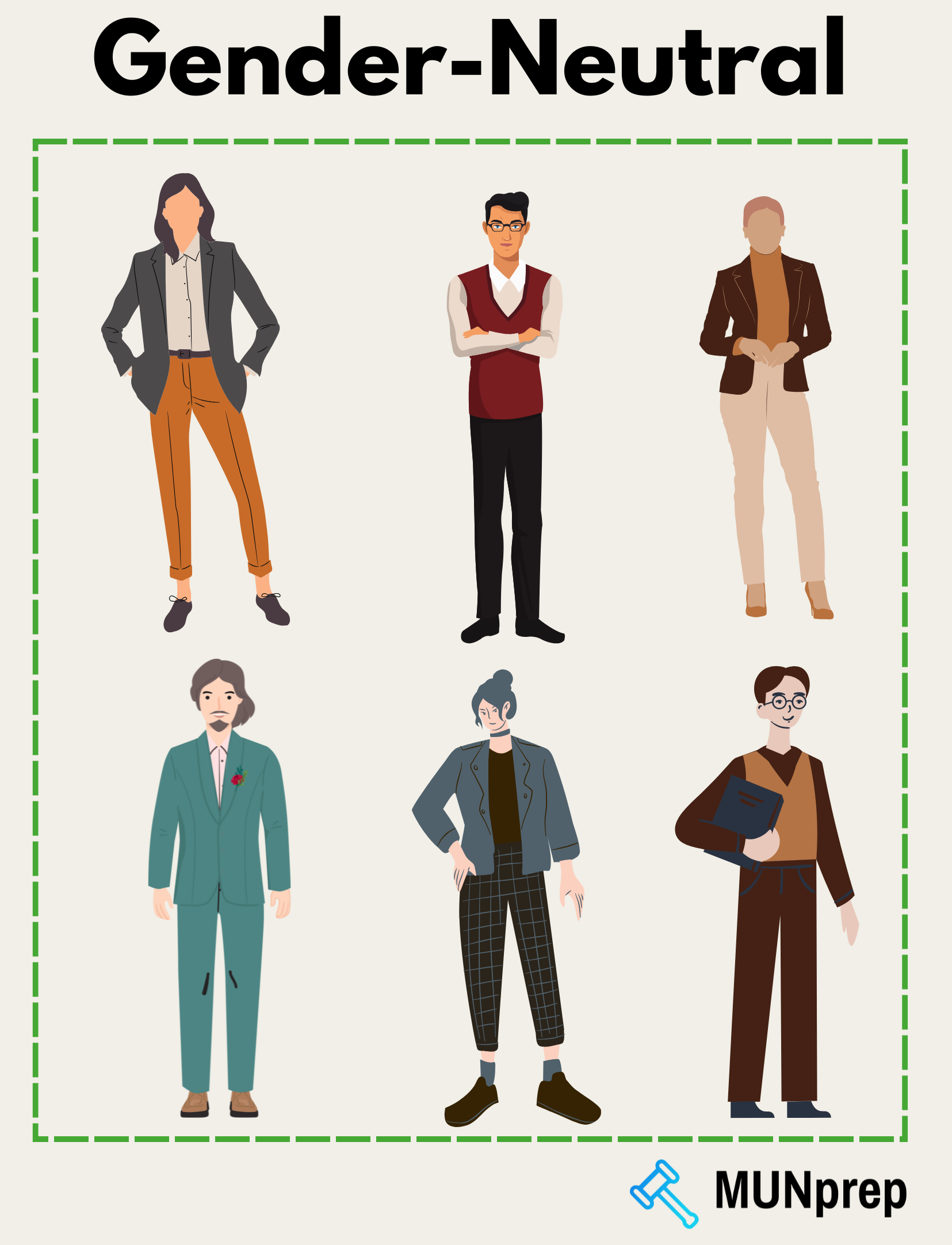
Gender-Neutral Dress-Code
For individuals seeking gender-neutral attire, the key is to maintain the professionalism expected at a Model UN conference, while selecting pieces that suit personal style and comfort.
Standard Attire:
- Suits: Neutral, tailored suits in black, gray, or navy, paired with a dress shirt or blouse.
- Shirts/Blouses: Collared shirts or blouses in neutral or pastel tones, without excessive embellishment.
- Shoes: Polished dress shoes or loafers in black, brown, or other neutral shades.
- Accessories: Minimalist jewelry or ties, depending on personal preference. Scarves in subtle colors can add a touch of flair.
Acceptable Variations:
- A blazer with coordinated dress pants or skirts.
- A tie or no tie, based on comfort and style.
- Oxford shirts paired with dress slacks for a slightly relaxed but professional look.
Unacceptable Variations:
- Clothing that is overly casual, such as jeans, hoodies, or sneakers.
- Ill-fitting attire that detracts from a professional appearance.
- Overly bright or bold patterns, slogans, or casual accessories like baseball caps.
Even more guidance on gender-neutral business attire
Even More Detail
The MUN dress code typically falls under Business Professional or Business Casual standards, depending on the conference. Here's what each entails:
Shoes
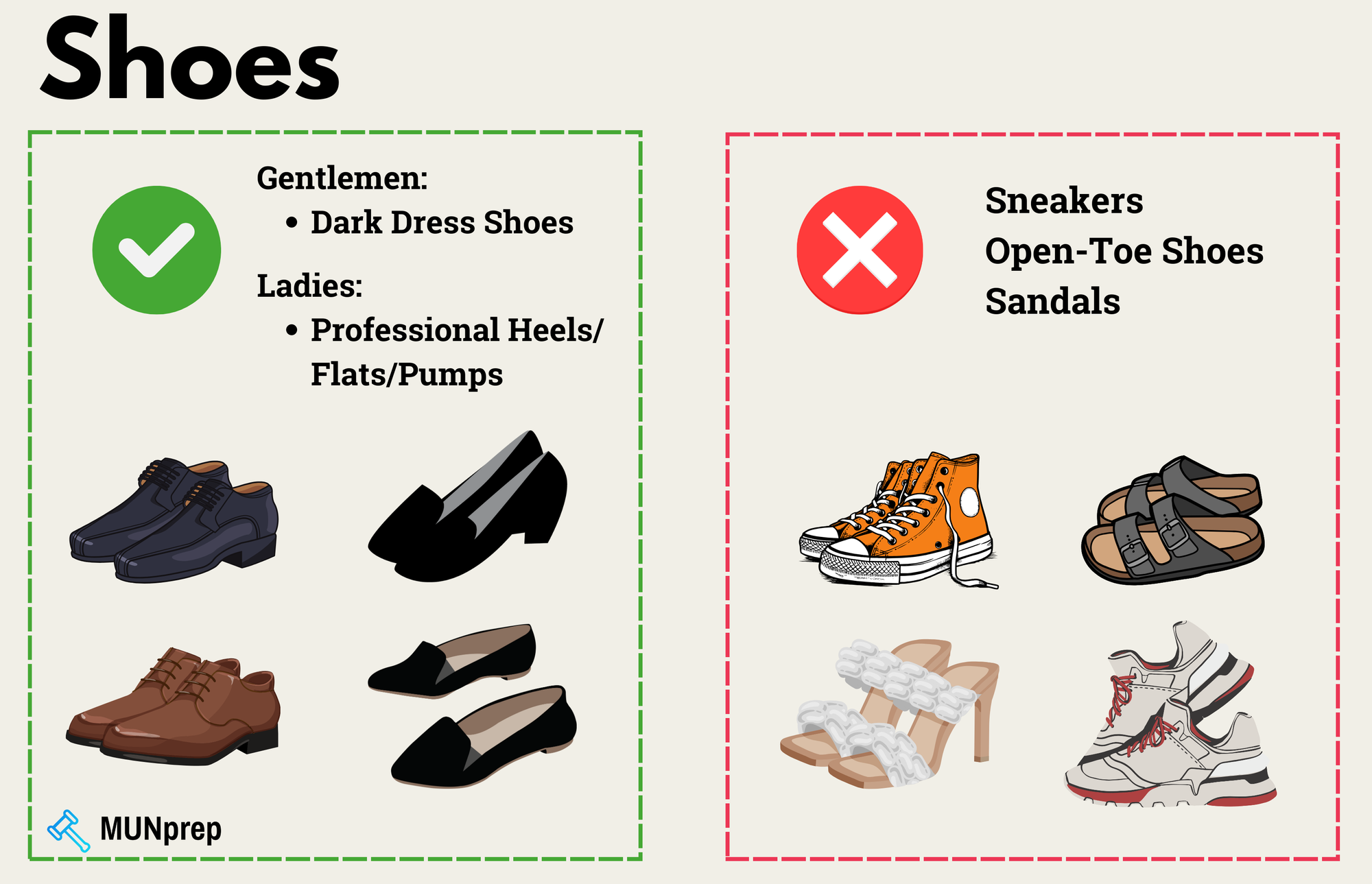
1. Shoes
Your choice of footwear significantly impacts the overall impression of your outfit. Shoes should complement your attire, be comfortable enough for long hours, and meet the professional standards of the event.
General Recommendations:
- Ensure shoes are clean, polished, and in good condition.
- Avoid casual or overly trendy footwear, as they can detract from the formal tone.
For Men:
- Recommended: Oxford or Derby shoes in black or brown are the most classic choices. Monk-strap shoes or leather loafers in neutral tones are also acceptable for slightly less traditional looks.
- Unacceptable: Sneakers, sandals, boat shoes, or any footwear with a visibly casual or sporty design.
For Women:
- Recommended: Closed-toe pumps with a moderate heel (2-3 inches), flats with a professional design, or block-heeled shoes for added comfort. Neutral tones such as black, navy, or beige are versatile options.
- Unacceptable: Open-toe shoes, stilettos higher than 4 inches, flip-flops, or overly embellished shoes that could be distracting.
For Gender Neutral Attire:
- Recommended: Leather loafers, brogues, or Oxford shoes in black, brown, or neutral colors. Comfort is especially important for long days.
- Unacceptable: Platform sneakers, casual boots, or shoes with overly bright or mismatched patterns.
Bags
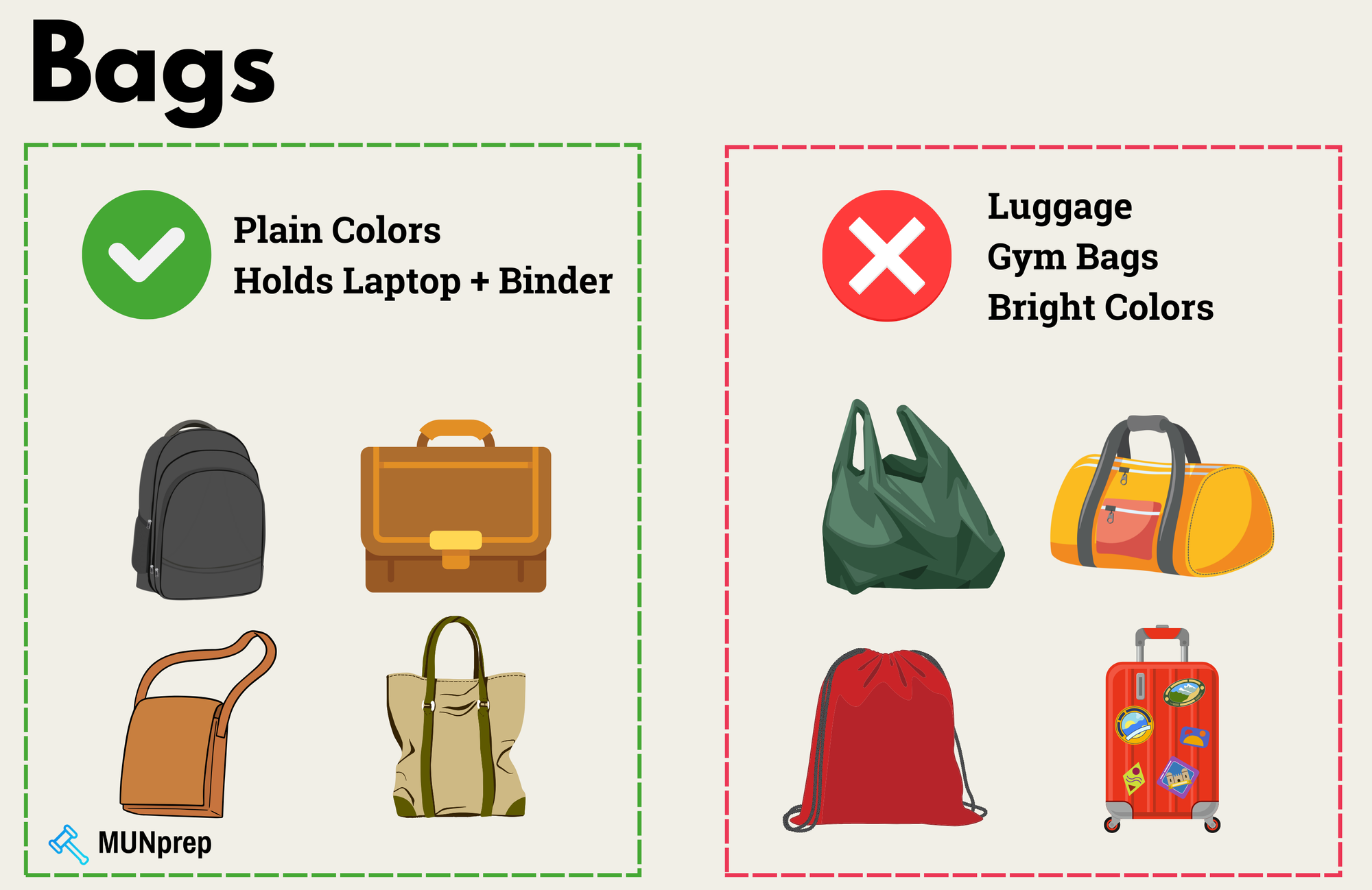
Bags
A professional bag not only completes your outfit but also ensures you can carry conference materials, such as position papers or notepads, in an organized manner.
General Recommendations:
- Choose a structured bag with clean lines and minimal decoration.
- Bags should be large enough to hold essential items but not oversized.
For Men:
- Recommended: A leather briefcase or a sleek messenger bag in neutral tones such as black or dark brown. For a modern twist, a laptop sleeve in a subdued color is also suitable.
- Unacceptable: Backpacks with casual or sporty designs, oversized duffel bags, or any bag with bright colors or large logos.
For Women:
- Recommended: Structured handbags, totes, or crossbody bags in neutral tones. Bags should have sufficient compartments for functionality while maintaining a polished appearance.
- Unacceptable: Large, casual totes, bags with excessive embellishments, or overly colorful or patterned designs that clash with professional attire.
For Gender Neutral Attire:
- Recommended: A minimalist satchel, backpack in leather or canvas with a professional design, or a slim briefcase in black, navy, or brown. These options cater to both style and utility.
- Unacceptable: Casual drawstring bags, large hiking backpacks, or brightly patterned fabric bags.
Accessories
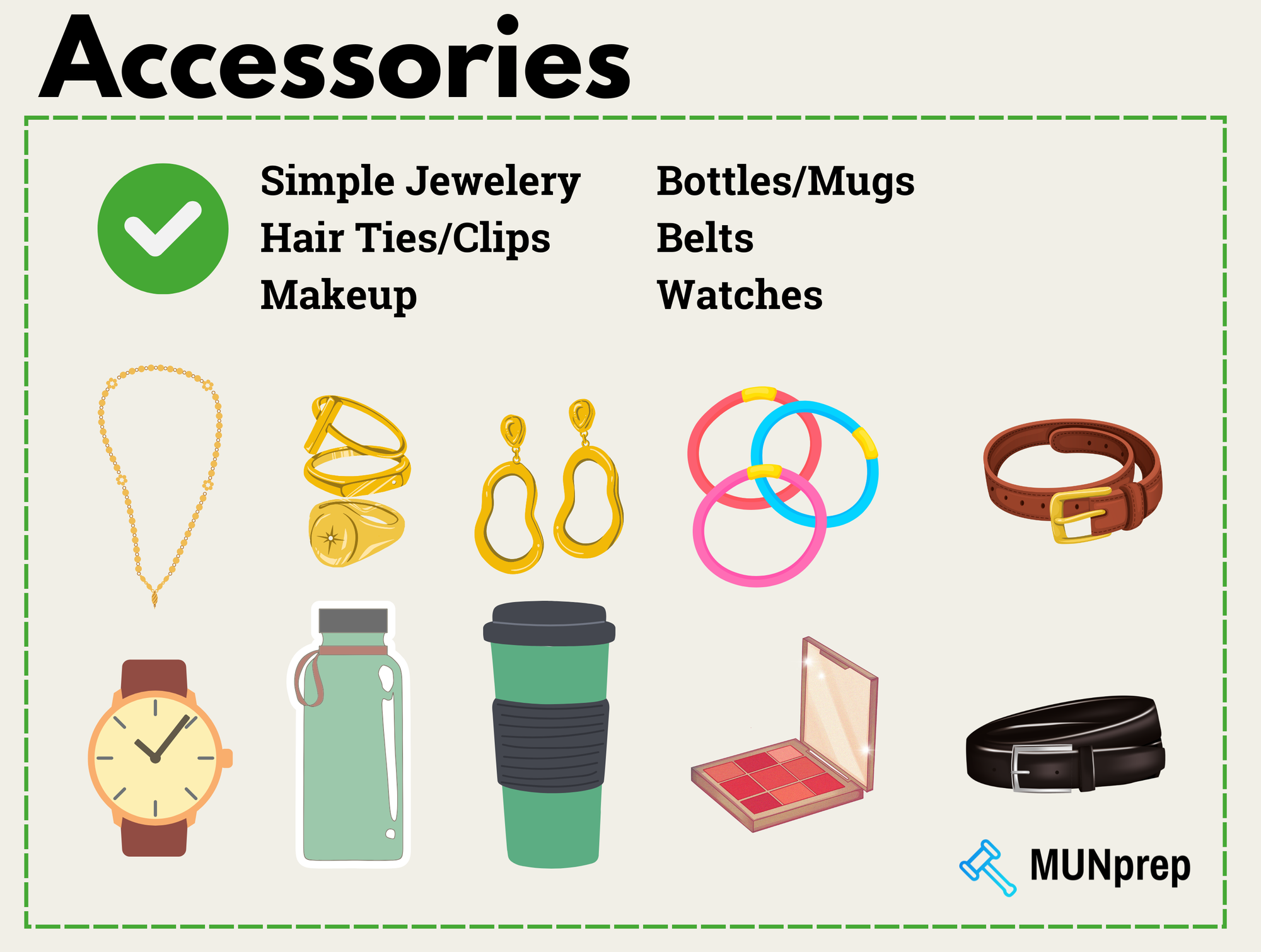
Accessories
Accessories add a touch of personality to your outfit while allowing you to maintain professionalism. Overdoing them, however, can detract from your appearance.
General Recommendations:
- Keep accessories minimal and tasteful.
- Avoid anything noisy, flashy, or distracting, as it can disrupt the formal tone of the conference.
For Men:
- Recommended: A conservative necktie or bow tie, cuff-links in subtle designs, and a wristwatch with a classic face. Pocket squares in solid or subtle patterns can elevate the suit.
- Unacceptable: Loud or novelty ties, oversized jewelry, or bright suspenders without a jacket.
For Women:
- Recommended: Simple jewelry, such as stud earrings, small hoops, or a delicate necklace. A slim belt can enhance a tailored outfit. Hair accessories should be understated and functional, like plain pins or headbands.
- Unacceptable: Oversized, jangling jewelry, flashy hair clips, or accessories with glitter, sequins, or bright rhinestones.
For Gender Neutral Attire:
- Recommended: A wristwatch with a neutral strap, a plain scarf, or lapel pins with subtle designs. Accessories should align with the overall tone of the outfit.
- Unacceptable: Accessories that are overly loud, novelty items (e.g., pins with slogans), or mismatched colors that clash with professional attire.
The Do's and Dont's of the Dress Code
Things to Avoid
Here are the most common pitfalls to steer clear of—avoid these to maintain your credibility and professionalism:
- Ignoring the "Business" in Business Attire: Overlooking the formal tone of a Model UN conference can make you stand out for the wrong reasons. Sweaters, denim, or casual dresses are all out of place.
- Lack of Consistency: Mixing styles—like wearing a formal blazer with casual sneakers—creates a mismatched look that diminishes your professionalism.
- Distracting Grooming Choices: Bold hairstyles, heavy makeup, or flashy nail colors can detract from the formal tone of the event. Aim for clean and simple grooming.
- Over-Preparedness Gone Wrong: Avoid overstuffed pockets, carrying multiple bags, or wearing every accessory you own. These choices can make you look cluttered rather than composed.
- Outfit Malfunctions: Ill-fitting clothing that restricts movement or footwear that causes discomfort will not only distract you but may also signal a lack of preparation. Test your outfit before the event to ensure a smooth experience.
Pro-Tips for Model UN Attire
Elevate your confidence and presentation with these professional hacks:
- Plan Ahead: Lay out your entire outfit, from socks to accessories, the night before to avoid last-minute scrambles. Pack a lint roller, sewing kit, or safety pins for emergency fixes.
- Comfort Meets Style: Conferences often involve long hours. Break in new shoes beforehand, and opt for breathable fabrics to stay comfortable without compromising formality.
- Bring Backup: Have a spare tie, blouse, or pair of socks on hand for unexpected accidents. A stain or rip is easier to handle if you’re prepared.
- Polish Your Look: Small details, like a clean haircut, ironed clothes, and polished shoes, make a big difference in how you’re perceived.
- Think Portable: Choose a bag that allows you to stay organized without carrying too much. Make sure there’s space for essentials like a notebook, water bottle, and phone charger.
- Add a Touch of Personality: While keeping within professional bounds, subtle choices like a unique lapel pin, tasteful tie pattern, or elegant scarf can help you stand out.
- Stay True to Yourself: Your confidence will shine when you feel comfortable in what you’re wearing. Stick to styles that align with your identity while respecting the formal dress code.
Final Points
Business Casual (Sometimes Allowed)
This is a less formal option often reserved for informal sessions or social events at MUN conferences.
- Men:
- Shirts: Collared shirts (solid or lightly patterned) or polo shirts.
- Pants: Dress pants, chinos, or khakis in neutral colors.
- Shoes: Loafers or dress shoes (sneakers are not acceptable).
- Accessories: Optional blazer or sweater.
- Women:
- Blouses/Tops: Button-down shirts, sweaters, or blouses.
- Pants/Skirts: Dress pants, knee-length skirts, or professional dresses.
- Shoes: Flats, loafers, or modest heels.
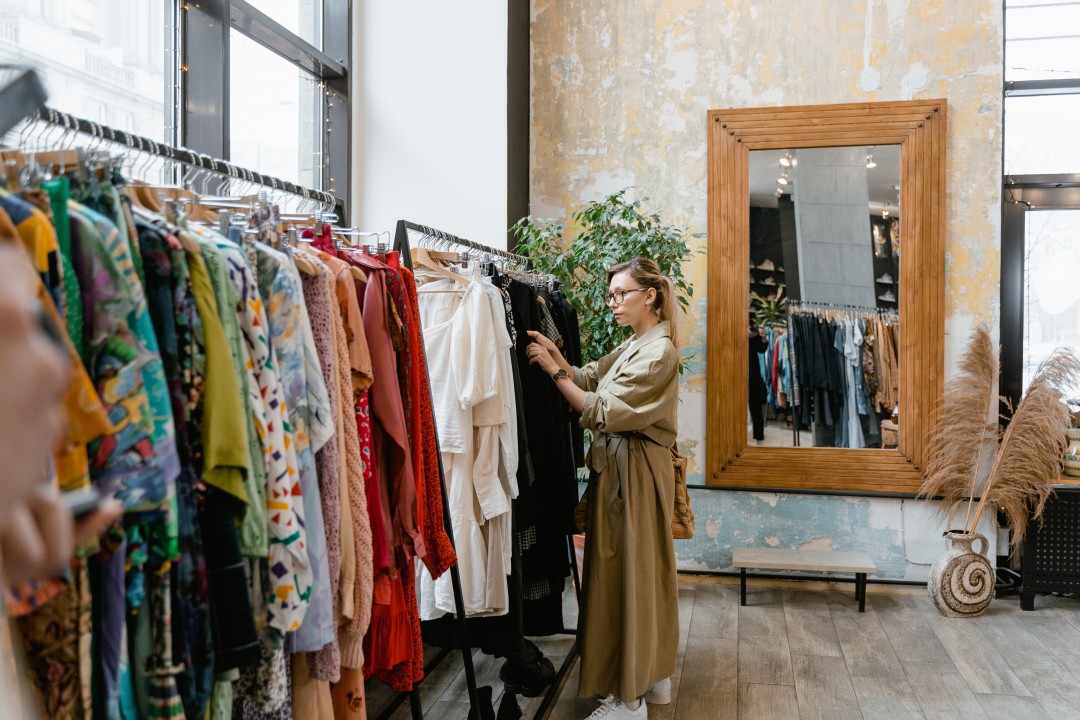
Cultural and Religious Attire
If you wish to wear traditional or religious attire, that’s welcomed in Model UN. Just ensure that it still aligns with a formal and professional look. For example, a tailored kurta, abaya, or kippah that matches the business standard is perfectly acceptable.
Dressing for the Social events
Mention something on social events
Closing Thoughts
Adhering to the MUN dress code is about more than just fitting in; it helps you embody the diplomatic character you’re representing. Dressing professionally will not only boost your confidence but also enhance your credibility among peers and in negotiations.
